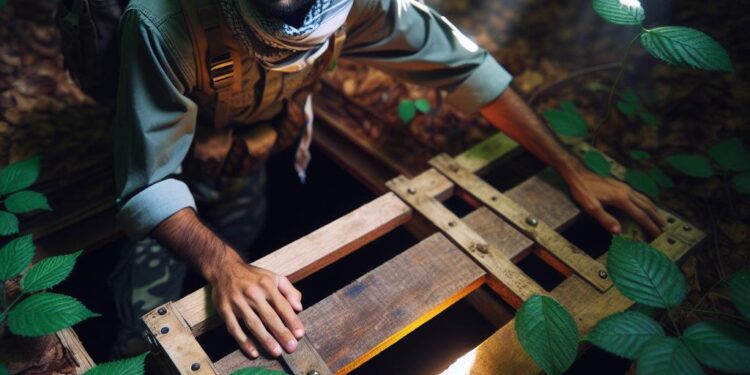In the ever-unpredictable realm of survival, ‘How to Make a Hidden Trapdoor Bunker’ offers a vital skill that could mean the difference between peril and safety during emergencies or off-grid situations. Whether you want a secret stash or a full-blown refuge, mastering this DIY project can provide you with a robust backup plan when the going gets tough. Often, people underestimate the importance of location, ventilation, and camouflage. This blog will peel back the layers of each crucial step, sharing practical advice and realistic solutions. Get ready to fortify your survival know-how with confidence and ease.
What Is a Hidden Trapdoor Bunker?
Alright, let’s dive into the intriguing world of survival with a touch of ingenuity. Imagine stepping into a realm where you’re not just building a hiding spot, but crafting a sophisticated, concealed sanctuary right beneath your feet. That’s the essence of creating a hidden trapdoor bunker. It’s like having your very own secret hideaway tucked into the earth, providing safety in emergencies, especially if you’re prepping for unforeseen events or venturing into off-grid living. Picture a sturdy door, concealed under the foliage of your garden, leading to a snug underground chamber. This space becomes your refuge during extreme weather or societal chaos, offering both security and peace of mind. By effectively merging practicality with stealth, you’re ensuring a layer of protection that’s both robust and undetectable. Whether it’s to store emergency supplies or simply relish some solitude away from prying eyes, a hidden trapdoor bunker becomes an innovative asset in your survival toolkit.Survival Benefits of a Hidden Trapdoor Bunker
Building a hidden trapdoor bunker isn’t just about having a cool hideout; it’s about enhancing your emergency preparedness and survival skills. Here’s why knowing how to create one can be a game-changer:- Enhanced Safety: A hidden trapdoor bunker offers a secure location away from threats, whether they’re environmental or human.
- High Survival Readiness: You’ll have a well-stocked refuge ready in case of a disaster, ensuring food, water, and other essentials are at hand.
- Gear Efficiency: With a dedicated space, your survival gear stays organized and easily accessible, reducing the time you’d spend searching for items during an emergency.
- Health in Emergencies: The stable environment of a bunker can protect against harmful weather, thus maintaining a healthier condition for you and your loved ones during adverse conditions.
- Reduced Reliance on Modern Systems: By having a self-sustaining space, you become less dependent on external utilities like electricity and water, which may fail in emergencies.
- Privacy and Discretion: A hidden entrance maintains privacy and ensures your bunker goes unnoticed, keeping your provision stash safe from opportunists.
- Peace of Mind: Ultimately, knowing you’ve got a backup plan can significantly reduce stress and give you peace of mind, knowing you’re prepared for the unexpected.
Daily Survival Tips from a Trapdoor Bunker Guide
- Create a concealed storage space: In an urban setting, use the trapdoor concept to build a hidden compartment for valuables in your home, keeping them safe from intruders.
- Emergency shelter: In rural areas, transform a trapdoor bunker into a discreet shelter, providing a secure hideout during unexpected weather events or security threats.
- Food storage: Use a hidden trapdoor to store non-perishable food supplies, ensuring readiness for emergencies without taking up visible space in your home.
- Practice stealth: Hone your ability to move and act discreetly, a skill useful for both urban neighbourhoods and isolated wilderness scenarios.
- Integrate into outdoor adventures: On a camping or hiking trip, the trapdoor principle can inspire creative ways to conceal equipment, elevating your survival strategy.
DIY Tips & Guided Use for Hidden Trapdoor Bunkers
Absolutely, let’s dive into some handy tips based on “How to Make a Hidden Trapdoor Bunker,” along with knowing when expert advice might come into play:- Start by understanding your location’s soil and climate. For those solo camping, a hidden bunker blends security and camping fun.
- If you’re a remote worker looking for seclusion, a trapdoor could serve as a secret workspace or quiet retreat.
- Use basic tools like shovels and hammers, but seek expert help if the landscape poses risks (e.g., uneven ground).
- Water can be tricky underground; consult a pro to prevent flooding if you’re near water bodies.
- Keep structure simple for beginners, leaving complex builds for courses or expert oversight.
- Consider local wildlife: meanwhile, campers might use a bunker for overnight safety.
Budget-Friendly & Quick Hidden Trapdoor Bunker Tips
Building a hidden trapdoor bunker requires careful planning, including understanding the costs and time commitment involved in its preparation.| Aspect | Cost/Time/Effort |
|---|---|
| Learning how to make a bunker | 10-20 hours researching and planning |
| Cost of materials for trapdoor bunker | £500 – £2000 depending on quality and size |
| Tools and equipment | £100 – £300, or borrow and save cost |
| Skilled labour (if hired) | £20 – £50 per hour, optional |
| DIY Effort | 40-60 hours of hands-on work |
| Maintenance and upkeep | 5-10 hours annually for checks and repairs |




